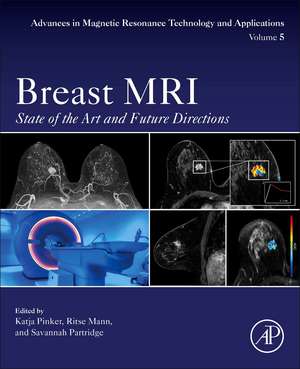Breast MRI: State of the Art and Future Directions: Advances in Magnetic Resonance Technology and Applications, cartea 5
Editat de Katja Pinker, Ritse Mann, Savannah Partridgeen Limba Engleză Paperback – 22 sep 2022
Breast cancer is one of the leading causes of death among women with early detection being the key to improved prognosis and survival. Magnetic resonance imaging (MRI) of the breast is undisputedly the most sensitive imaging method to detect cancer, with a higher detection rate than mammography, digital breast tomosynthesis, and ultrasound.
- Spans the whole spectrum of breast MRI, including basic imaging techniques, indications, interpretation, and the latest cutting-edge techniques
- Reviews multiparametric MRI and abbreviated protocols, providing an outlook on the future of this technique
- Discusses the predictive and prognostic value of MRI as well as the evolving field of radiomics/genomics and AI
Preț: 739.66 lei
Preț vechi: 960.73 lei
-23% Nou
Puncte Express: 1109
Preț estimativ în valută:
141.54€ • 151.35$ • 118.01£
141.54€ • 151.35$ • 118.01£
Carte tipărită la comandă
Livrare economică 11-25 aprilie
Livrare express 13-19 martie pentru 102.55 lei
Preluare comenzi: 021 569.72.76
Specificații
ISBN-13: 9780128227299
ISBN-10: 012822729X
Pagini: 644
Ilustrații: 105 illustrations (80 in full color)
Dimensiuni: 191 x 235 x 35 mm
Greutate: 1.11 kg
Editura: ELSEVIER SCIENCE
Seria Advances in Magnetic Resonance Technology and Applications
ISBN-10: 012822729X
Pagini: 644
Ilustrații: 105 illustrations (80 in full color)
Dimensiuni: 191 x 235 x 35 mm
Greutate: 1.11 kg
Editura: ELSEVIER SCIENCE
Seria Advances in Magnetic Resonance Technology and Applications
Public țintă
MRI researchers with a background in physics, computer science, biomedical engineering, mathematics, biophysicsRadiologist, clinicians
Cuprins
Section 1. Performance and Interpretation of Breast MRI
1. Breast Magnetic Resonance Imaging Protocols
i.Abbreviated and Ultrafast MRI
ii.Multiparametric MRI in clinical practice
2. Artifacts
3. BI-RADS
4. The Kaiser score: an evidence-based clinical decision rule for dynamic contrast-enhanced breast MRI
5. Background parenchymal enhancement
Section 2. MRI Characteristics of Common Breast Lesions
6. Benign
7. High-risk
8. DCIS
9. Invasive cancers
Section 3. Clinical Indications for Breast MRI
10. Screening
11. Staging and treatment planning
12. Response assessment to neoadjuvant therapy
13. Follow-up: Posttreatment changes and Recurrent Breast Cancer
14. Breast Augmentation and Post-mastectomy Autologous Breast Reconstruction
15. Problem Solving
16. Cancer of Unknown Primary including Imaging of the Axilla
Section 4: Breast Magnetic Resonance Imaging-guided Interventions and Therapy
17. Biopsy including MRI-directed US and rad-path correlation
18. Monitoring Therapy
Future Directons
Section 5. Advanced and Emerging Approaches
19. Non-contrast MRI
20. Ultra-high field magnets
21. Pharmacokinetic modelling
22. Diffusion MRI of the breast: standard and advanced techniques
23. Proton Magnetic Resonance Spectroscopy
24. Emerging MRI Techniques: CEST, BOLD, Sodium, Phospohorus MRS, Lipid MRS, HP MRI
Section 6: Hybrid Imaging and Alternative Techniques
25. PET/MRI hybrid imaging and targeted tracers
26. Alternative techniques: CEM and MBI
Section 7: Prognostic and Predictive MR imaging biomarkers
27. MRI Radiomics and Radiogenomics for Breast Cancer
28. Artificial Intelligence and Deep Learning
1. Breast Magnetic Resonance Imaging Protocols
i.Abbreviated and Ultrafast MRI
ii.Multiparametric MRI in clinical practice
2. Artifacts
3. BI-RADS
4. The Kaiser score: an evidence-based clinical decision rule for dynamic contrast-enhanced breast MRI
5. Background parenchymal enhancement
Section 2. MRI Characteristics of Common Breast Lesions
6. Benign
7. High-risk
8. DCIS
9. Invasive cancers
Section 3. Clinical Indications for Breast MRI
10. Screening
11. Staging and treatment planning
12. Response assessment to neoadjuvant therapy
13. Follow-up: Posttreatment changes and Recurrent Breast Cancer
14. Breast Augmentation and Post-mastectomy Autologous Breast Reconstruction
15. Problem Solving
16. Cancer of Unknown Primary including Imaging of the Axilla
Section 4: Breast Magnetic Resonance Imaging-guided Interventions and Therapy
17. Biopsy including MRI-directed US and rad-path correlation
18. Monitoring Therapy
Future Directons
Section 5. Advanced and Emerging Approaches
19. Non-contrast MRI
20. Ultra-high field magnets
21. Pharmacokinetic modelling
22. Diffusion MRI of the breast: standard and advanced techniques
23. Proton Magnetic Resonance Spectroscopy
24. Emerging MRI Techniques: CEST, BOLD, Sodium, Phospohorus MRS, Lipid MRS, HP MRI
Section 6: Hybrid Imaging and Alternative Techniques
25. PET/MRI hybrid imaging and targeted tracers
26. Alternative techniques: CEM and MBI
Section 7: Prognostic and Predictive MR imaging biomarkers
27. MRI Radiomics and Radiogenomics for Breast Cancer
28. Artificial Intelligence and Deep Learning













